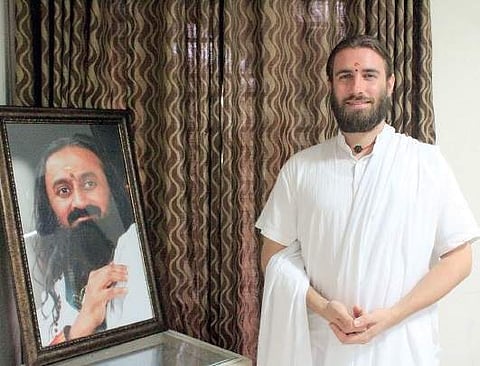

KOCHI: On a recent Monday morning, Swami Purnachaitanya steps on to a foot-high concrete platform at the Art of Living Ashram in Kollam. He then puts his hands together in a namaste, bows his head towards the garlanded photograph of founder Sri Sri Ravi Shankar on the wall and then sits cross-legged in front of a low table covered by a white cloth. Two lighted lamps have been placed in front. Two priests are sitting on either side of the table. The audience consists of devotees, visitors and volunteers.
Swami Purnachaitanya then adjusts his shoulder-length hair, while, through the sound system, the words ‘Namo Namo’ are repeated.Swami Purnachaitanya is about to perform the Rudra Puja, which is in honour of Lord Shiva. It is one of his favourite pujas. In 2004, he participated in his first Rudra puja at Bengaluru. “When I closed my eyes and listened to the mantras, my mind became calm,” he says. “Half an hour later, I was in a deep state of meditation.”
What is unusual about Swami Purnachaitanya is that he is from Holland (original name: Alexander Luthra). When he was 16, he saw Sri Sri Ravi Shankar in a public meeting at Holland and was much impressed.“Some of the things Sri Sri Ravi Shankar said made a lot of sense,” says Swami Purnachaitanya. “He spoke about how we have a tendency to identify with our smaller identities, like being an architect or a member of a community. He said that one of the reasons for many of the problems with the world is that we identify with these small identities, and not with the bigger one that we are all human beings and part of the planet.”
Then, a few months later, Swami Purnachaitanya attended his first Art Of Living programme and was drawn to the meditation and breathing techniques that allowed him to calm his mind. Thereafter, he attended many other workshops.
During a gap year, after high school, Swami Purnachaitanya spent a couple of months doing volunteer work at the Art of Living headquarters in Bengaluru and was much impressed. Following his graduation in journalism, new media and Indology in 2007, he joined the ashram. Today, the Bengaluru-based Swami is Director of Programmes and International Faculty. And his work profile is to look after all the activities in the seven states of the North-East, as well as West Bengal. He also travels abroad, to give talks and conduct programmes in places like Hongkong, United Arab Emirates, Sri Lanka, Nepal, Bhutan and Europe.
Asked about the common problems facing people, Swami Purnachaitanya says, “Many people fulfill their ambitions of becoming rich, having a house and car and other comforts, but then they realise that it does not bring happiness. In fact, there is an inner emptiness.”
Another problem is that technology is overwhelming people. “You are being bombarded with messages and information all the time,” says Swami Purnachaitanya. “And it becomes difficult to process all this information. The whole society is speeding up. As a result, most people are exhausted. You sleep for eight hours and you wake up still feeling tired.”
Hence, Swami Purnachaitanya teaches people different methods to calm the mind. “The easiest way is by observing the breath,” says the Swami. “So, we teach the Sudarshan Kriya.” This involves using cyclical breathing patterns: from slow, medium to rapid. In this way, you gain control of your breath; this has an immediate effect on your nerves, mind and immune system. There are four types of breaths: Ujjayi (Victorious Breath); Bhastrika (Bellows Breath); Om Chant, and Kriya (Purifying Breath).
As Swami Purnachaitanya speaks, it is difficult to believe that he is Dutch, because his accent is pure Indian. “That’s because I have lived ten years in India,” he says. “Or maybe because I have 25 percent Indian DNA.”
The Swami’s grandfather, who was from Delhi, married a Dutch woman. They had a daughter, Sonia, as well as a son, but separated after a while. Thereafter, the mother went to Holland with the children. “My mother, Sonia, could not speak any Indian language at all because there was no direct exposure,” says Swami Purnachaitanya. “But India had always been in her DNA. And that is also the case with me.”